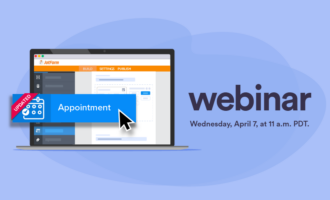“Webinar” is a very broad term. In short, it’s an online event that connects a speaker or speakers with viewers around the world. Webinars are broadcast in real time over the internet and are interactive, in many cases allowing viewers to respond to speakers and hold a conversation.
While webinars are often broadcast live, they can also be downloaded and watched after they’ve been broadcast. In this way, they aren’t just a communication method that pays off in the moment — they can also be a source of evergreen content that viewers go back to again and again.
How does a webinar work?
Video conferencing software facilitates a webinar. Popular webinar platforms include EverWebinar, WebinarJam, Webex, and countless others. While most webinar software touts the same basic capabilities, different platforms have different features, which means you might prefer one tool based on your goals.
You’ll first want to publicize your webinar. If you’re putting on a webinar for employees, you might send out an email that lists the time for the webinar and a link that allows recipients to view the webinar.
You may be running a webinar for potential customers who are looking to learn more about your business. In this case, you might have them sign up for the webinar via a form, after which you’ll send an email that invites them to the webinar.
What are the benefits of a webinar?
The benefits of webinars are numerous — and many of these benefits grow out of the fact that webinars are so easy to attend. After all, who doesn’t like watching a lecture or presentation from the comfort of their own home? Here are a few more reasons webinars are the right choice:
- They require very little equipment. Forget about buying expensive equipment. To record a webinar, you typically need only a quality webcam — which just about every laptop has built in nowadays. Most computers also have quality microphones to pick up your voice, but if you want to ensure top-flight audio quality, you can always spend some money on a stronger microphone. The need for so little equipment makes it easy to quickly set up a webinar.
- They’re affordable. In the past, you’d have to rent a venue for a major speech. Now, because you don’t need a live audience, a webinar requires only your office and a few pieces of equipment.
- Webinars position you as a thought leader. Companies that frequently run webinars convey an important message: They have lots to say and aren’t afraid to say it. By organizing a webinar, you show that you have experts in your company who can communicate ideas effectively. And if your webinar contextualizes a major use case for your product, it can have a dramatic impact on your sales.
- They’re highly interactive. It’s easier than ever for speakers to get feedback while they deliver a webinar. That’s because more and more software enables viewers to leave comments in real time. Speakers can also quickly launch polls in the middle of their webinar to get quantitative feedback in an instant. Beyond getting feedback, interactivity also turns your webinar into a conversation and an easy, enlightening exchange of ideas.
How does a webinar differ from a podcast?
You might be wondering how webinars differ from podcasts. After all, both involve communicating ideas over the internet. Podcasts and webinars are quite similar. It’s easy for many users to download the audio of a webinar and listen to it, meaning it functions almost exactly like a podcast.
Webinars tend to place more of an emphasis on video and live broadcast. Are they always live? No. Do they always involve a video component? Not necessarily. But when people think of a webinar, they often think of a live broadcast that is being recorded.
The tone of podcasts and webinars can also differ. Podcasts are more commonly a source of entertainment, whereas webinars often place more of an emphasis on information — though again, the lines are blurred and the best webinars and podcasts blend information and entertainment.








































































Send Comment: